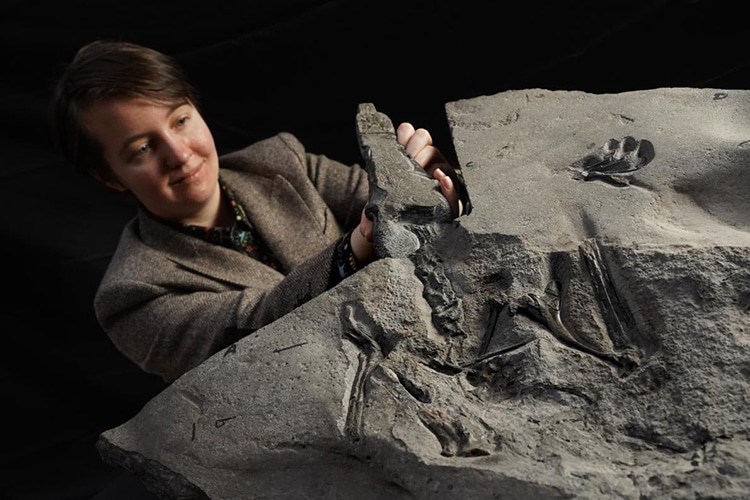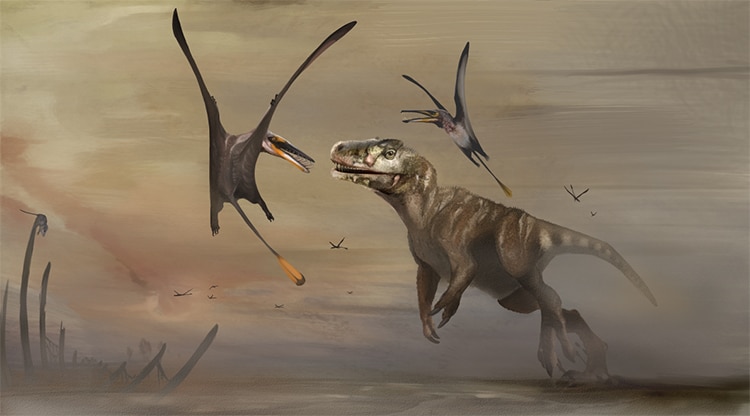
The fossil is removed from its discovery location on the Isle of Skye in 2017. (Photo: Shasta Marrero/University of Edinburgh)
Scotland’s Isle of Skye is known for its beautiful rocky cliffs and brilliant green fields. It was upon one of the island’s rocky beaches that a team of scientists made a shocking discovery in 2017. The expedition—funded by the National Geographic Society—discovered a large jawbone poking out of a rock. The jawbone turned out to be part of an enormous pterosaur fossil, a type of winged reptile from the Jurassic Period. Naming the species Dearc sgiathanach, Gaelic for “winged reptile,” the team published their finding of this important fossil in Current Biology.
Amelia Penny—a paleontology PhD student—first noticed the fossil on the beach in 2017. Her discovery led to a frantic yet careful excavation by the team as they fought to free the fossil before the rising tides swallowed the bones. Steve Brusatte of the University of Edinburgh led the expedition. “It was nearly midnight when we finished removing it, and we were heaving around 400 pounds off the beach with our torches and headlamps,” Brusatte told NBC. “It was really the most stressed I’ve been as far as a discovery in the field.”
The fossil is the most complete pterosaur ever discovered in Scotland. Pterosaurs were winged reptiles, and the earliest creatures to use powered flight (flapping their wings for lift). Because these creatures had hollow, light bones, finding well-preserved fossils are a rarity. While they roamed from 230 million years ago (Triassic period) to 66 million years ago (late Cretaceous period), the Isle of Skye specimen dates to about 170 million years ago. The researchers named it Dearc sgiathanach as homage to both the creature’s wings and the Gaelic meaning of the island’s name, “the winged isle.”
The fossil fills an evolutionary gap in the history of the pterosaur. Although not fully grown, the fossil is larger than many specimens of the Jurassic period. Adults may have had wingspans of over 8 feet. They also appear to have large optic lobes, implying excellent eyesight. Natalia Jagielska, PhD student and lead author of the paper, stressed how special a find this fossil is. “Its sharp fish-snatching teeth still [retain] a shiny enamel cover as if he were alive mere weeks ago,” she said in a statement. The fossil will continue to be studied and will eventually join the collection of the National Museums Scotland.
Scientists in Scotland discovered an exceptionally complete pterosaur fossil on the Isle of Skye.

PhD student Natalia Jagielska with the 170-million-year-old fossil. (Photo: Stewart Attwood/University of Edinburgh)
Researchers date the fossil to about 170 million years ago and named it in Gaelic, Dearc sgiathanach.

Artistic depiction of the flying reptile. (Photo: Natalia Jagielska/University of Edinburgh)
h/t: [NBC]
Related Articles:
Amazing Fossil Find Shows a Non-Avian Dinosaur Sitting On Its Nest of Unhatched Eggs
220-Million-Year-Old Dinosaur Footprint Is Discovered by a 4-Year-Old
World’s Oldest DNA Is Discovered in a 1.2-Million-Year-Old Mammoth
Fossil Discovery Unlocks the Mystery of What Happened the Day the Dinosaurs Died
